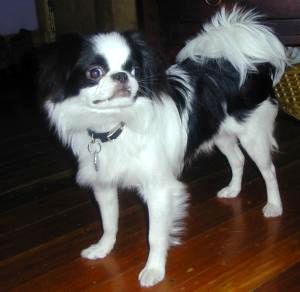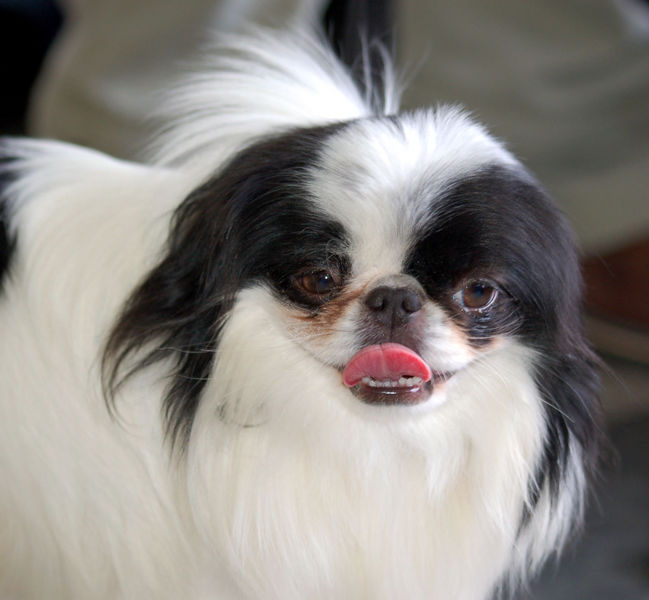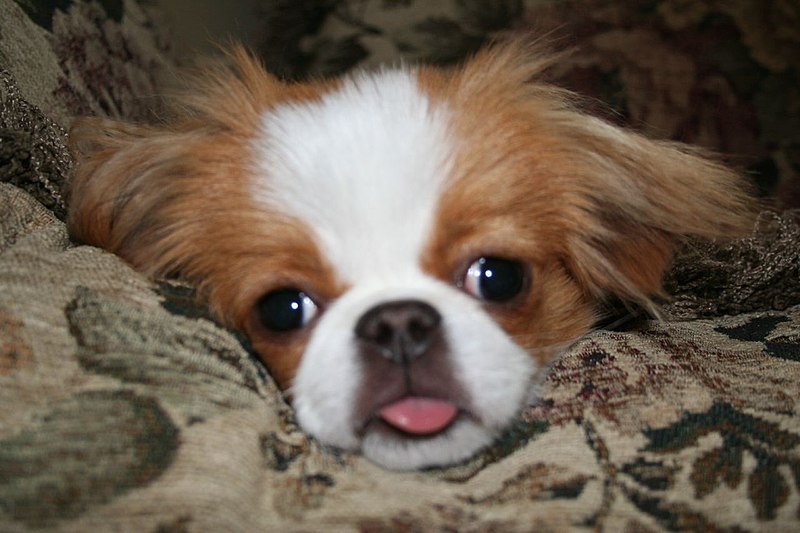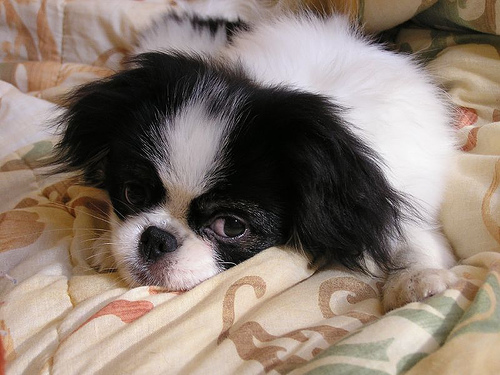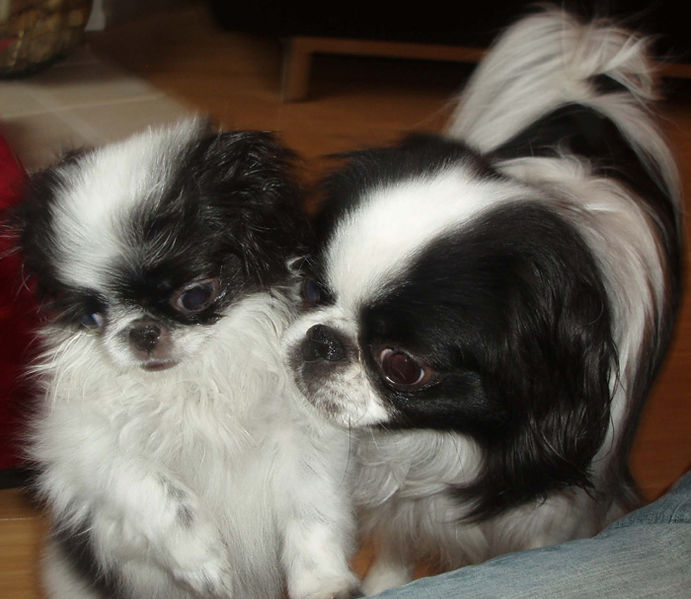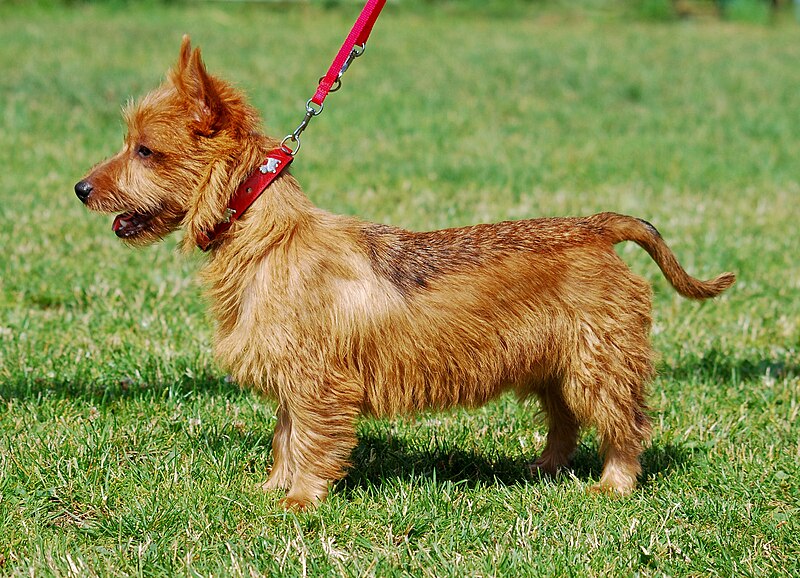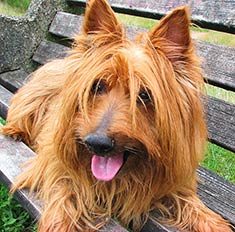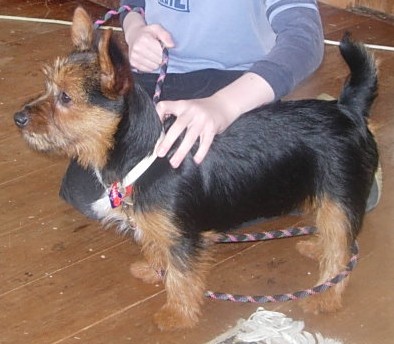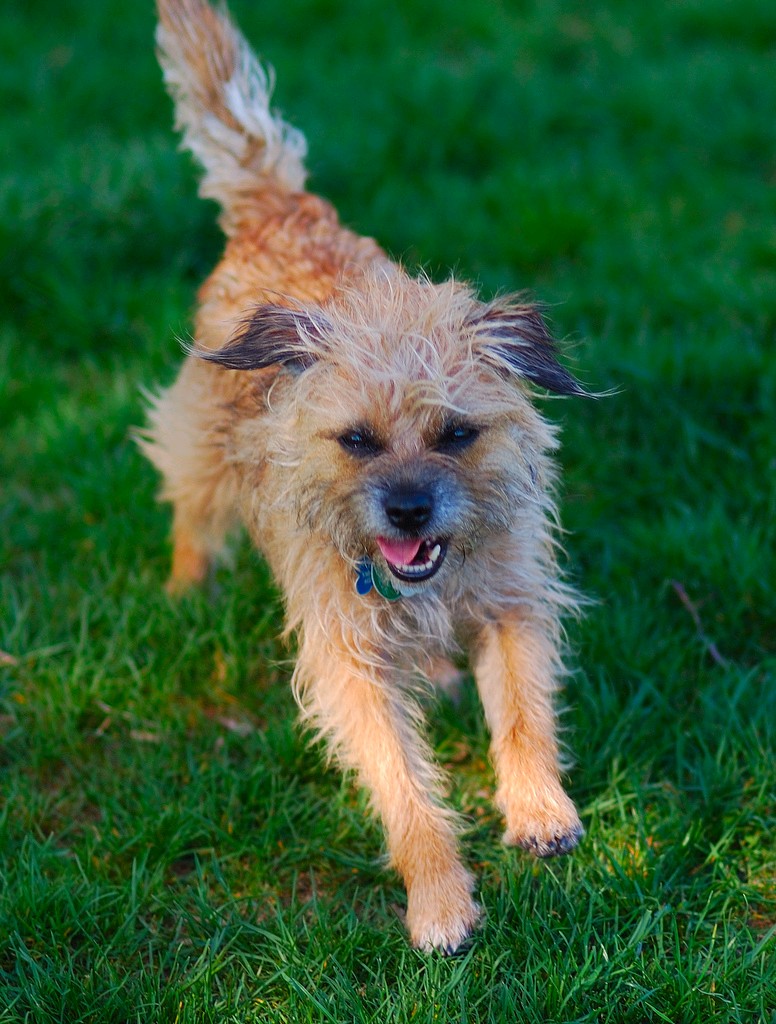The Japanese Chin (狆), also known as the Japanese Spaniel) is the dog of Japanese royalty. A lap dog and companion dog, this toy breed has a distinctive heritage.
Appearance
Japanese Chin stand about 20 to 27 cm (8 to 11 in) in height at the withers and weight can vary from a low of 4 lbs to a high of 20 lbs, with an average of 7 to 11 pounds being the most common. The American Kennel Club and the Fédération Cynologique Internationale give no weight requirement for the Chin in their published Breed Standards.
Chin have straight, silky, profuse long hair that is most often black and white, or white and black, with other acceptable colorations being red and white (which includes lemon yellow and white), sable and white and, rarely, black and white with tan points, also commonly referred to as a “Tri-Color.” They have heavily feathered tails that curl up over their backs with the long hair cascading down one side, often reaching the floor; the chest, neck and shoulder area is also heavily coated, with the hair springing away from the body creating the appearance of a thick ruff.
The Chin is considered a “head breed,” with a slightly oversized head that is square or blocky with a slight rounding between the ears; this rounding should not be so round as to be domed in appearance. It is ideal to have a white hourglass-shaped patch of hair over the face and skull; this patch commonly has a black spot or blaze in the center of the skull which is known as a Buddha's Thumbprint. This designation is often attributed to the Emperor Ming of Han China, who is said to have owned many of these dogs. The face should have an "oriental" appearance, with a short, upturned muzzle and large, wide-set eyes that have white visible in the inner corners, creating an astonished expression.
Temperament
This breed is considered one of the most cat-like of the dog breeds in attitude: it is alert, intelligent, and independent, and it uses its paws to wash and wipe its face. Other cat-like traits include their preference for resting on high surfaces such as the backs of sofas and chairs, their ability to walk across a coffee table without disturbing an item, and some of the surprising places their owners often find them in. They rank 62nd in Stanley Coren's The Intelligence of Dogs, being of fair working/obedience intelligence. A companion dog, it is loving and loyal to its owner and typically happy to see other people, though a few are distrustful of strangers. Chin prefer familiar surroundings, but do quite well in new situations and are often used as therapy dogs because of this trait and their love of people. Very early socialization of Chin puppies leads to a more emotionally well-balanced Chin that is more accepting of different situations and people.
The Chin will bark for the purpose of alerting the household to the arrival of a visitor or something out of the ordinary, but are otherwise very quiet.
Chin were bred for the purpose of loving and entertaining their people. While typically a calm little dog, they are well known for performing many enjoyable antics such as the “Chin Spin,” in which they turn in rapid circles; dancing on their hind legs while pawing their front feet, clasped together, in the air; and, some even “sing,” a noise that can range from a low trill to a higher, almost operatic quality noise, and which sounds much like “boooo.”
Health
This breed's flattened face contributes to a few Chin suffering from breathing and heart problems, as is common with brachycephalic breeds. Because they are a brachycephalic breed, temperature extremes (particularly heat) should be avoided. Luxating patellas (knees) and heart murmurs are other genetically predisposed conditions. The oversized eyes are easily scratched and corneal scratches or more serious ulcerations can result. Mild scratches benefit from topical canine antibacterial ointment specifically for eye application; more serious injury or ulcerations require urgent medical care. The Chin, as with most small breed dogs, can also have a risk of hypoglycemia when under the age of 6 months; this concern can continue in Chin that mature at 4 to 5 pounds or less. Some Chin do have seasonal allergies.
A 6 month old Japanese Chin
Care
The Chin's coat requires nothing more than brushing or combing once every day or two to maintain its appearance, with special attention being given to the area under the ears and legs and to the skirt; they have no coat odor and do not require frequent bathing. Chin are single-coated and single-hair shedders, much like people, and it is very seldom one will find a Chin with an undercoat. Occasionally, a Chin will have a light blowing of their coat once a year. Without fiber in the diet, they may need to have their anal glands expressed bimonthly. The oversized eye orbits contribute to moisture about the face and the skin folds in and around the nose and flattened facial area can trap moisture and cause fungal problems. The face should be occasionally wiped with a damp cloth and the folds cleaned with a cotton swab.
Diet is an important factor in the health and condition of the Chin, with many Chin being very sensitive or allergic to corn. Maintaining a Chin on a high quality kibble that contains no corn will do much to avoid skin and allergy conditions.
Due to low exercise requirements, the Chin makes a perfect condominium or apartment pet. The use of "housetraining pads" is recommended. The Chin is very easy to housetrain with many learning the use of a doggie door (some as young as 8 weeks old) in a day’s time with assistance from their person. Similarly, it is very easy to train them to the housetraining pads, or even a litter box, by limiting their area until they have mastered use of the pads or litter box.
History
The true origin of the Chin remains a matter of controversy. It is widely agreed that these dogs originated in China. Some maintain the ancestors of these dogs first appeared in Japan around the year 732, as gifts from the rulers of Korea, while others maintain that they were given as gifts to the Empress of Japan as early as the mid-6th century to 7th century, and even some saying they came to Japan as recently as around the year 1000.
The Chin were the dogs of Japanese nobility and each noble house bred to their own standards. Because of this, there are many variations of the Chin in any area from size to coat density, eye set, personality, whether they are compact and well-muscled or slender-boned and fragile in appearance, etc.
Professor Ludvic von Schulmuth studied canine origins by studying the skeletal remains of dogs found in human settlements as long as the 8th millennium BC.[citation needed] The Professor created a genealogical tree of Tibetan dogs that shows the "Gobi Desert Kitchen Midden Dog", a scavenger, evolved into the "Small Soft-Coated Drop-Eared Hunting Dog". From this dog evolved the Tibetan Spaniel, Pekingese, and Japanese Chin`. Another branch coming down from the "Kitchen Midden Dog" gave rise to the Papillon and Long-haired Chihuahua and yet another "Kitchen Midden Dog" branch to the Pug and Shih Tzu.
Though there is some documentation that indicates Portuguese sailors introduced the breed to Europe in the 17th century by presenting some to Catherine of Braganza, Queen Consort to King Charles II of England, there is more credible evidence that the first Chin were gifted by the Emperor of Japan to an American naval officer, Matthew Calbraith Perry, when Perry visited the Orient in 1853 to open trade with the East. Perry was gifted with a total of seven (7) Chin; however, only two survived the passage back. Again, there is controversy over whether Perry gave the two to Franklin Pierce, President of the United States, gave them to James Stirling, Rear admiral of the Royal Navy to take to Queen Victoria, or gave them to his daughter , Caroline Slidell,after returning from Japan. Caroline was the wife of August Belmont.


